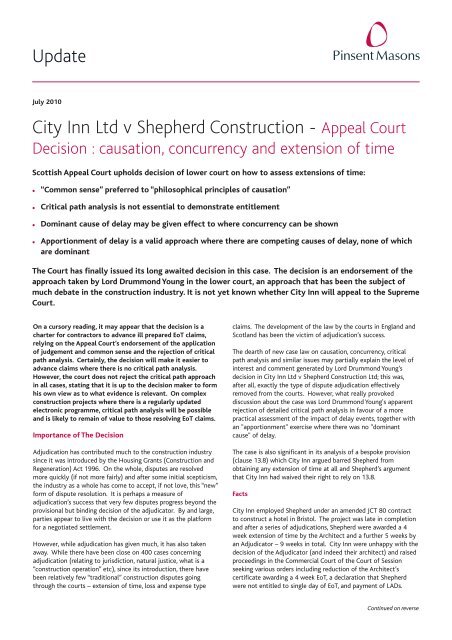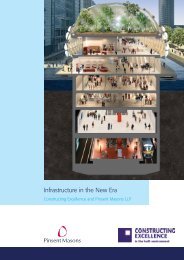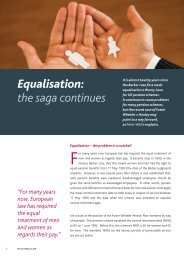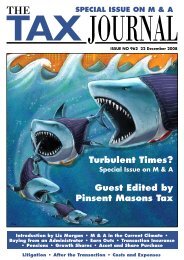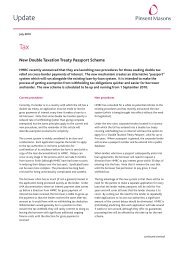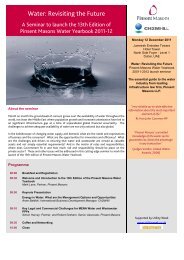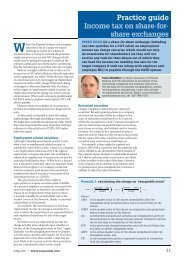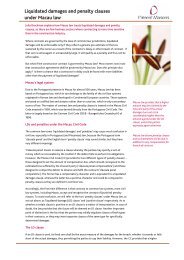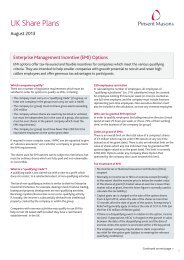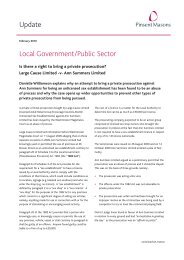City Inn Ltd v Shepherd Construction - Jul 10 ... - Pinsent Masons
City Inn Ltd v Shepherd Construction - Jul 10 ... - Pinsent Masons
City Inn Ltd v Shepherd Construction - Jul 10 ... - Pinsent Masons
Create successful ePaper yourself
Turn your PDF publications into a flip-book with our unique Google optimized e-Paper software.
Update<br />
<strong>Jul</strong>y 20<strong>10</strong><br />
<strong>City</strong> <strong>Inn</strong> <strong>Ltd</strong> v <strong>Shepherd</strong> <strong>Construction</strong> - Appeal Court<br />
Decision : causation, concurrency and extension of time<br />
Scottish Appeal Court upholds decision of lower court on how to assess extensions of time:<br />
<br />
<br />
<br />
<br />
“Common sense” preferred to “philosophical principles of causation”<br />
Critical path analysis is not essential to demonstrate entitlement<br />
Dominant cause of delay may be given effect to where concurrency can be shown<br />
Apportionment of delay is a valid approach where there are competing causes of delay, none of which<br />
are dominant<br />
The Court has finally issued its long awaited decision in this case. The decision is an endorsement of the<br />
approach taken by Lord Drummond Young in the lower court, an approach that has been the subject of<br />
much debate in the construction industry. It is not yet known whether <strong>City</strong> <strong>Inn</strong> will appeal to the Supreme<br />
Court.<br />
On a cursory reading, it may appear that the decision is a<br />
charter for contractors to advance ill prepared EoT claims,<br />
relying on the Appeal Court’s endorsement of the application<br />
of judgement and common sense and the rejection of critical<br />
path analysis. Certainly, the decision will make it easier to<br />
advance claims where there is no critical path analysis.<br />
However, the court does not reject the critical path approach<br />
in all cases, stating that it is up to the decision maker to form<br />
his own view as to what evidence is relevant. On complex<br />
construction projects where there is a regularly updated<br />
electronic programme, critical path analysis will be possible<br />
and is likely to remain of value to those resolving EoT claims.<br />
Importance of The Decision<br />
Adjudication has contributed much to the construction industry<br />
since it was introduced by the Housing Grants (<strong>Construction</strong> and<br />
Regeneration) Act 1996. On the whole, disputes are resolved<br />
more quickly (if not more fairly) and after some initial scepticism,<br />
the industry as a whole has come to accept, if not love, this “new”<br />
form of dispute resolution. It is perhaps a measure of<br />
adjudication’s success that very few disputes progress beyond the<br />
provisional but binding decision of the adjudicator. By and large,<br />
parties appear to live with the decision or use it as the platform<br />
for a negotiated settlement.<br />
However, while adjudication has given much, it has also taken<br />
away. While there have been close on 400 cases concerning<br />
adjudication (relating to jurisdiction, natural justice, what is a<br />
“construction operation” etc), since its introduction, there have<br />
been relatively few “traditional” construction disputes going<br />
through the courts – extension of time, loss and expense type<br />
claims. The development of the law by the courts in England and<br />
Scotland has been the victim of adjudication’s success.<br />
The dearth of new case law on causation, concurrency, critical<br />
path analysis and similar issues may partially explain the level of<br />
interest and comment generated by Lord Drummond Young’s<br />
decision in <strong>City</strong> <strong>Inn</strong> <strong>Ltd</strong> v <strong>Shepherd</strong> <strong>Construction</strong> <strong>Ltd</strong>; this was,<br />
after all, exactly the type of dispute adjudication effectively<br />
removed from the courts. However, what really provoked<br />
discussion about the case was Lord Drummond Young's apparent<br />
rejection of detailed critical path analysis in favour of a more<br />
practical assessment of the impact of delay events, together with<br />
an "apportionment" exercise where there was no "dominant<br />
cause" of delay.<br />
The case is also significant in its analysis of a bespoke provision<br />
(clause 13.8) which <strong>City</strong> <strong>Inn</strong> argued barred <strong>Shepherd</strong> from<br />
obtaining any extension of time at all and <strong>Shepherd</strong>’s argument<br />
that <strong>City</strong> <strong>Inn</strong> had waived their right to rely on 13.8.<br />
Facts<br />
<strong>City</strong> <strong>Inn</strong> employed <strong>Shepherd</strong> under an amended JCT 80 contract<br />
to construct a hotel in Bristol. The project was late in completion<br />
and after a series of adjudications, <strong>Shepherd</strong> were awarded a 4<br />
week extension of time by the Architect and a further 5 weeks by<br />
an Adjudicator – 9 weeks in total. <strong>City</strong> <strong>Inn</strong> were unhappy with the<br />
decision of the Adjudicator (and indeed their architect) and raised<br />
proceedings in the Commercial Court of the Court of Session<br />
seeking various orders including reduction of the Architect’s<br />
certificate awarding a 4 week EoT, a declaration that <strong>Shepherd</strong><br />
were not entitled to single day of EoT, and payment of LADs.<br />
Continued on reverse
After some initial legal skirmishes regarding whether clause 13.8<br />
amounted to a penalty, the case proceeded to a proof (i.e. trial)<br />
before Lord Drummond Young.<br />
Lord Drummond Young’s opinion<br />
The evidence showed that neither party, nor the Architect, had<br />
made any reference to clause 13.8 during the contract, with<br />
applications for EoT being made and considered as if the clause did<br />
not exist. Indeed, it became clear that the first time <strong>City</strong> <strong>Inn</strong> ever<br />
sought to rely on clause 13.8 was during adjustment of its written<br />
claim, sometime after the court action had been raised and a<br />
number of years after the job was finished.<br />
With regard to delay, it was clear that, particularly towards the end<br />
of the project, there were various events, some Relevant Events<br />
and some events which were attributable to <strong>Shepherd</strong>, which were<br />
all potentially causing delay to completion – concurrency in a<br />
broad sense. Questions of causation and the proper approach to<br />
concurrency were therefore in sharp focus.<br />
<strong>Shepherd</strong> had been unable to locate an electronic, logic linked<br />
version of its original programme. All that was available was a<br />
fairly rudimentary programme showing activities and durations.<br />
An as-built programme was agreed between the two experts. <strong>City</strong><br />
<strong>Inn</strong>'s expert then sought to retrospectively establish the critical<br />
path through the job – a critical path which avoided many of the<br />
matters upon which <strong>Shepherd</strong> relied (e.g. the hotel's roof) leading<br />
him to the conclusion that <strong>Shepherd</strong> were not entitled to a single<br />
day’s EoT.<br />
<strong>Shepherd</strong>’s expert, on the other hand, gave evidence that he had<br />
tried to establish the critical path, but felt that it was impossible to<br />
do so reliably. Instead, he checked the original programme in order<br />
to ascertain whether or not it was reasonable and then looked to<br />
the as built programme to see where delay occurred with reference<br />
to the as planned programme. He then looked to what had caused<br />
delay at various points in time and used his experience and<br />
judgement to offer an opinion as to the effect on completion.<br />
At the trial, numerous errors were identified in <strong>City</strong> <strong>Inn</strong>’s critical<br />
path analysis, errors which were eventually conceded by their<br />
expert.<br />
Clause 13.8 and waiver<br />
Lord Drummond Young agreed with views previously expressed by<br />
Lord Macfadyen that it would make no sense for clause 13.8 to<br />
apply to instructions/variations which caused delay not as a result<br />
of their content, but as a result of their timing i.e. if they were late.<br />
He also found that <strong>City</strong> <strong>Inn</strong> had effectively waived their right to<br />
rely on clause 13.8 by their director’s failure to mention the<br />
provision in face to face discussions with <strong>Shepherd</strong> and the fact<br />
that <strong>Shepherd</strong> had thereafter administered the contract as if clause<br />
13.8 did not exist. There was evidence, which he accepted, to the<br />
effect that if <strong>City</strong> <strong>Inn</strong>/the Architect had refused an early EoT<br />
application on the basis of non-compliance with clause 13.8,<br />
<strong>Shepherd</strong> would thereafter have applied clause 13.8 to the latter.<br />
Causation, concurrency and delay<br />
In his opinion, Lord Drummond concluded that the task of the<br />
decision maker under clause 25 was to make a "judgment" and<br />
ultimately arrive at a "fair and reasonable" decision on an<br />
extension of time. Where there was concurrency, i.e. the Relevant<br />
Event and the contractor risk event existing at the same time,<br />
irrespective of when the events began (or ended), in the absence of<br />
one event being "dominant", achieving a fair and reasonable<br />
outcome may involve an apportionment exercise. In reaching this<br />
view, Lord Drummond Young also noted that the "but for" test of<br />
causation did not apply in the context of clause 25. Having set<br />
out these principles, Lord Drummond Young went on to consider<br />
the evidence and the competing approaches of the two experts.<br />
Lord Drummond Young rejected <strong>City</strong> <strong>Inn</strong>’s critical path analysis and<br />
preferred the evidence of <strong>Shepherd</strong>'s expert and applying his<br />
approach to clause 25 found <strong>Shepherd</strong> entitled to a 9 week<br />
extension of time (the same as had been awarded by the<br />
adjudicator). <strong>City</strong> <strong>Inn</strong> appealed.<br />
Court of Appeal decision<br />
All three appeal judges rejected <strong>City</strong> <strong>Inn</strong>’s appeal (which ran to 17<br />
grounds) although on the critical questions of causation and<br />
concurrency, two judges follow and elaborate on Lord Drummond<br />
Young’s approach while the third judge takes a different approach.<br />
All three judges agreed with Lord Drummond Young on waiver and<br />
clause 13.8 (although one judge took a slightly different approach<br />
to the 13.8 issue)<br />
The aspect of the decision, however, which is sure to attract most<br />
attention relates to the proper application of clause 25 and how to<br />
deal with issues of concurrency and causation.<br />
The majority opinion was given by Lord Osborne with whom Lord<br />
Kingarth agreed. Having reviewed the authorities and Lord<br />
Drummond Young’s analysis, Lord Osborne sets out 5 propositions<br />
relative to the proper approach to the application of clause 25.<br />
1. Before any claim for an extension of time can succeed, it must be<br />
shown that the Relevant Event is likely to delay or has delayed the<br />
works.<br />
2. Whether or not the Relevant Event actually causes delay is "an<br />
issue of fact which is to be resolved, not by the application of<br />
philosophical principles of causation, but rather by the<br />
application of principles of common sense."<br />
3. The decision maker can decide the question of causation (i.e.<br />
whether the event has caused delay to completion) by the use of<br />
whatever evidence he considers appropriate. If demonstrated to<br />
be sound, this may take the form of a critical path analysis, but the<br />
absence of such an analysis does not mean the claim will<br />
necessarily fail.<br />
4. If a dominant cause can be identified in respect of the delay, effect<br />
will be given to that by leaving out of account any cause or causes<br />
that are not material. If the Dominant Cause is not a Relevant<br />
Event, the claim will fail.<br />
5. Where there are two causes operating to cause delay, neither of<br />
which is dominant and only one of which is a Relevant Event, a<br />
contractor's claim for an extension of time will not necessarily fail.<br />
Rather, it is for the decision maker "...approaching the issue in a<br />
fair and reasonable way, to apportion the delay in completion of<br />
the works...as between the relevant event and the other event."<br />
Lord Carloway concurred in the result, but rejected the concept of<br />
apportionment. On his approach, the Architect’s sole task is to<br />
consider whether or not the Relevant Event, viewed in isolation is<br />
going to delay completion. If it is, then the next question is what<br />
award of EoT would be fair and reasonable. Even for Lord<br />
Carloway, however, the matter is one of “common sense.”<br />
Continued on next page
All three judges agreed that a critical path analysis was not<br />
essential to carry out the exercise (although it may be relevant).<br />
All three judges also disagreed with HHJ Seymour QC’s comments<br />
in Royal Brompton Hospital NHS Trust v Hammond to the effect<br />
that a Relevant Event falls to be disregarded if a pre-existing<br />
contractor default would nonetheless have caused delay.<br />
What does the decision mean in practice?<br />
In Scotland at least, the decision is now binding on lower courts.<br />
In England, it is not binding, but given that it is an appeal court<br />
decision, is very persuasive. So what is the likely impact of the<br />
decision?<br />
<strong>City</strong> <strong>Inn</strong> had argued that the “but for test” of causation fell to be<br />
applied strictly such that even where there was “true concurrency”<br />
i.e. a Relevant Event commencing at the same time as a non<br />
relevant event, the contractor would not be entitled to an<br />
extension of time because it could not be said that “but for” the<br />
Relevant Event occurring, there would be delay.<br />
However, all the judges appear to place great weight on the need<br />
to reach a “fair and reasonable” decision on EoT. Lord Osborne<br />
appears to be unimpressed by the various attempts at<br />
classification of "concurrent delay" or "concurrent delaying events”<br />
stating that, "...it may not be of importance to identify whether<br />
some delaying event or events was concurrent with another, in any of<br />
the possible narrow senses described, but rather to consider the<br />
effect upon the completion date of relevant events and events not<br />
relevant. For that reason, discussion of whether or not there is true<br />
concurrency, in my opinion, does not assist in the essential process to<br />
be followed under clause 25."<br />
Lord Carloway speaks about the Architect applying “professional<br />
judgement” and “using his and not a lawyer’s common sense.”<br />
The decision is also a rejection of the argument that a critical path<br />
analysis is essential to demonstrate an EoT entitlement. <strong>City</strong> <strong>Inn</strong><br />
did not try to revive their delay analysis at the appeal, but they<br />
urged the court to hold that in the absence of a critical path<br />
analysis supportive of <strong>Shepherd</strong>'s position, the <strong>Shepherd</strong> claim had<br />
to fail. The court does not completely discount the value of<br />
critical path analysis – but it appears to be for the decision maker<br />
to decide if such evidence is of assistance to him or her. A claim<br />
will not necessarily fail in the absence of such evidence.<br />
A majority of the court also support Lord Drummond Young’s<br />
apportionment exercise in the event of concurrency where no<br />
cause is dominant, although Lord Osborne does emphasise that it<br />
is “open” to the architect to apportion as part of approaching the<br />
issue in a fair and reasonable way – he is not compelled to do so.<br />
The case amounts to a statement that common sense, judgement<br />
and experience are to be preferred to an overly complicated<br />
analysis of causation. However, the case is most certainly not a<br />
charter to those who wish to cut corners in the presentation of<br />
EoT claims. <strong>Shepherd</strong> were successful because the judge found<br />
that it was not possible to accurately re-create the critical path<br />
through the job. If accurate electronic programming data is<br />
available, then a decision maker may take the view that it is<br />
relevant, albeit that issue of dominance will also need to be<br />
addressed where there is concurrency.<br />
<strong>Pinsent</strong> <strong>Masons</strong> acted for <strong>Shepherd</strong> <strong>Construction</strong>.<br />
This note does not constitute legal advice. Specific legal advice should be taken before acting on any of the topics covered.<br />
LONDON DUBAI BEIJING SHANGHAI HONG KONG SINGAPORE<br />
OTHER UK LOCATIONS: BIRMINGHAM BRISTOL EDINBURGH GLASGOW LEEDS MANCHESTER<br />
T 0845 300 32 32<br />
© <strong>Pinsent</strong> <strong>Masons</strong> LLP 20<strong>10</strong><br />
Should you have any questions please contact Alastair Walls (alastair.walls@pinsentmasons.com) or your usual <strong>Pinsent</strong> <strong>Masons</strong><br />
adviser who will be able to assist you further.<br />
<strong>Pinsent</strong> <strong>Masons</strong> LLP is a limited liability partnership registered in England & Wales (registered number: OC333653) and regulated by the Solicitors Regulation Authority. The word 'partner', used in relation to<br />
the LLP, refers to a member of the LLP or an employee or consultant of the LLP or any affiliated firm who is a lawyer with equivalent standing and qualifications. Singapore location in association with MPillay.<br />
A list of members of the LLP, and of those non-members who are designated as partners, is displayed at the LLP's registered office: <strong>City</strong>Point, One Ropemaker Street, London, EC2Y 9AH, United Kingdom. We<br />
use ‘<strong>Pinsent</strong> <strong>Masons</strong>’ to refer to <strong>Pinsent</strong> <strong>Masons</strong> LLP and affiliated entities that practise under the name ‘<strong>Pinsent</strong> <strong>Masons</strong>’ or a name that incorporates those words. Reference to ‘<strong>Pinsent</strong> <strong>Masons</strong>’ is to <strong>Pinsent</strong><br />
<strong>Masons</strong> LLP and/or one or more of those affiliated entities as the context requires. For important regulatory information please visit: www.pinsentmasons.com<br />
www.pinsentmasons.com


